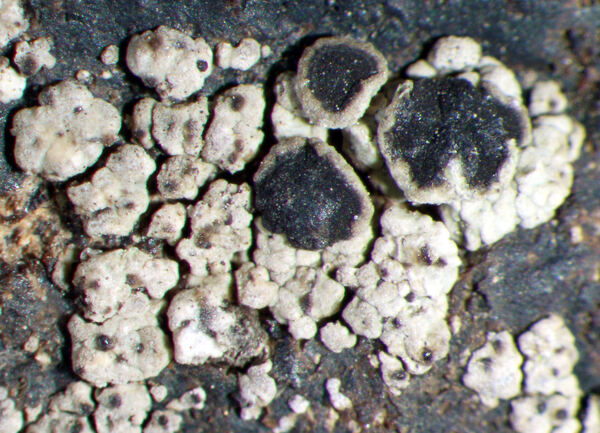Rinodina santorinensis J. Steiner
Verh. zool.-bot. Ges. Wien, 69: 55, 1919.
Synonyms:
Distribution: C - Tosc (Mayrhofer & al. 1993), Laz (Mayrhofer & al. 1993), Sar (Mayrhofer & al. 1993). S - Camp (Mayrhofer & al. 1993), Si (Mayrhofer & al. 1993, Ottonello & al. 2011).
Description: Thallus crustose, episubstratic, rimose-areolate, up to 2 mm thick, whitish or pale to dark grey, usually delimited by a black prothallus, often starting the life-cycle on epilithic Pertusaria-species and other crustose lichens. Areoles flat to convex, often sublobate or subsquamulose, with a brown lower surface. Medulla white, I-. Apothecia lecanorine, 0.7-1.7(-2) mm across, adnate to sessile, with a flat, dark brown to black, sometimes whitish-pruinose disc, and a thick, smooth or crenulate, persistent proper margin. Proper exciple dark brown in upper part, colourless below; epithecium red-brown to dark brown, rarely with a granular epipsamma reacting P+ orange; hymenium colourless, 70-90(-100) μm high; paraphyses 1-2 μm thick at mid-level, the apical cells 3-6 μm wide; hypothecium colourless, to 300 μm high. Asci 8-spored, clavate, the K/I+ blue tholus penetrated by a faintly amyloid apical cushion with parallel or diverging flanks, the wall K/I-, surrounded by a K/I+ blue outer layer, Lecanora-type. Ascospores 1-septate, brown, ellipsoid, (14-)15-21(-22) x 8-12(-14) μm, at first Pachysporaria-type, then tending towards the Physcia-type, the wall warted, with a well-developed torus, the ontogeny of type A (apical wall thickening after septum formation). Pycnidia common, black, immersed in the thallus, with slightly prominent ostioles. Conidia bacilliform, 3.5-5 x 1-1.5 μm. Photobiont chlorococcoid. Spot tests: thallus K+ yellow, C-, KC-, P+ orange. Chemistry: atranorin, sometimes chloroatranorin, pannarin.Note: a mainly Mediterranean-Macaronesian species found on different types of base-rich, especially volcanic rocks in areas under maritime influence, often starting the life-cycle on other crustose lichens; exclusively Tyrrhenian in Italy; related to R. beccariana.
Growth form: Crustose
Substrata: rocks
Photobiont: green algae other than Trentepohlia
Reproductive strategy: mainly sexual
paras crustose lichens
Taxon bound to maritime-coastal situations
Commonnes-rarity: (info)
Alpine belt: absent
Subalpine belt: absent
Oromediterranean belt: absent
Montane belt: absent
Submediterranean belt: absent
Padanian area: absent
Humid submediterranean belt: absent
Humid mediterranean belt: rather rare
Dry mediterranean belt: extremely rare
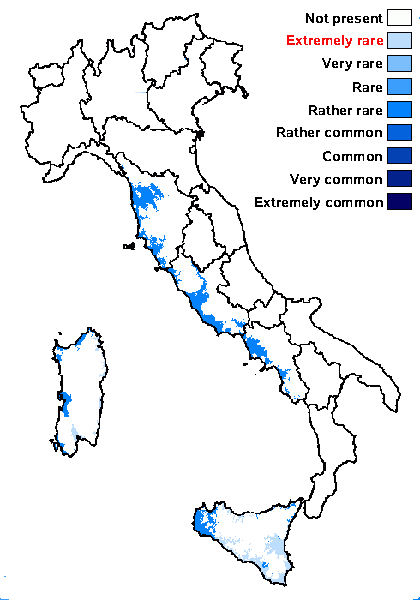
Predictive model
Herbarium samples
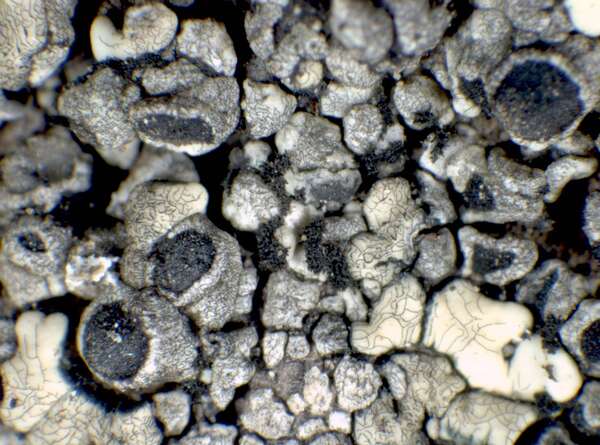

P.L. Nimis; Owner: Department of Life Sciences, University of Trieste
Herbarium: TSB (19750)
2001/11/29
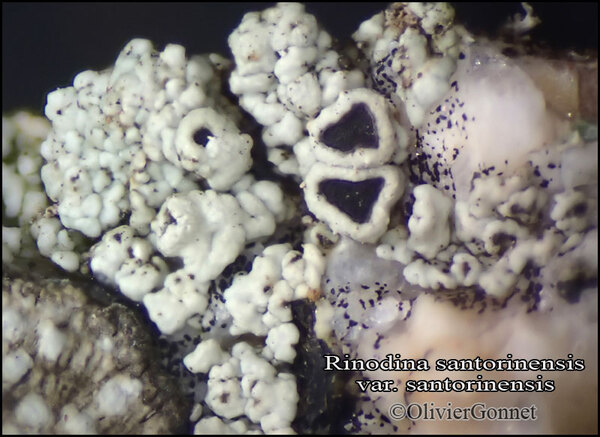
Courtesy Danièle et Olivier Gonnet - Source: hhttps://www.afl-lichenologie.fr/Photos_AFL/Photos_AFL_R/Textes_R/Rinodina_santorinensis.htm
France, 12/10/2015 - Punta di Ventilegne - Corse
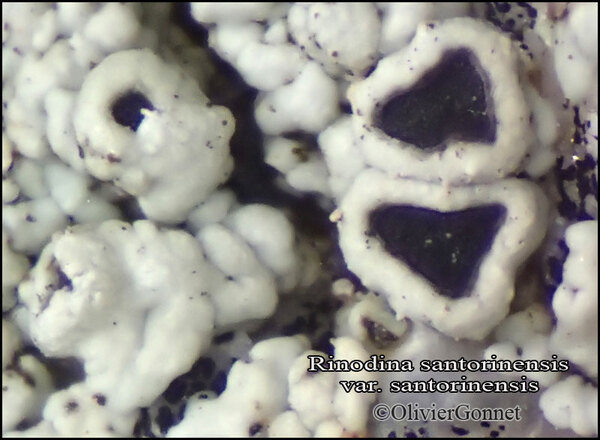
Courtesy Danièle et Olivier Gonnet - Source: hhttps://www.afl-lichenologie.fr/Photos_AFL/Photos_AFL_R/Textes_R/Rinodina_santorinensis.htm
France, 12/10/2015 - Punta di Ventilegne - Corse
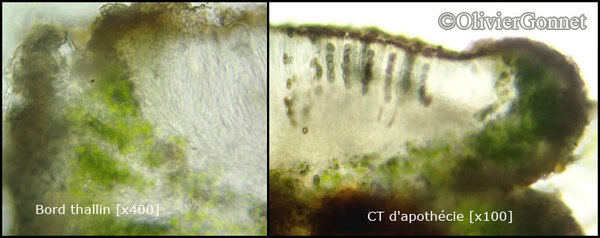
Courtesy Danièle et Olivier Gonnet - Source: hhttps://www.afl-lichenologie.fr/Photos_AFL/Photos_AFL_R/Textes_R/Rinodina_santorinensis.htm
France, 12/10/2015 - Punta di Ventilegne - Corse
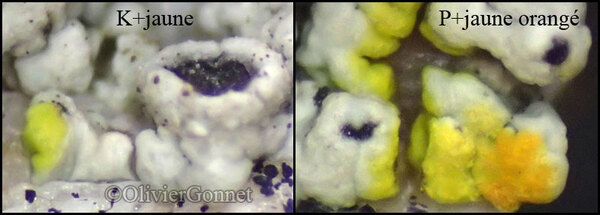
Courtesy Danièle et Olivier Gonnet - Source: hhttps://www.afl-lichenologie.fr/Photos_AFL/Photos_AFL_R/Textes_R/Rinodina_santorinensis.htm
France, 12/10/2015 - Punta di Ventilegne - Corse
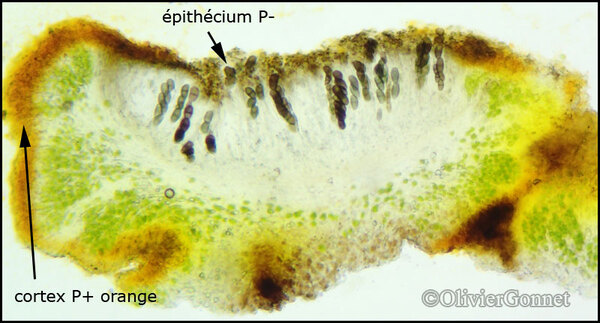
Courtesy Danièle et Olivier Gonnet - Source: hhttps://www.afl-lichenologie.fr/Photos_AFL/Photos_AFL_R/Textes_R/Rinodina_santorinensis.htm
France, 12/10/2015 - Punta di Ventilegne - Corse
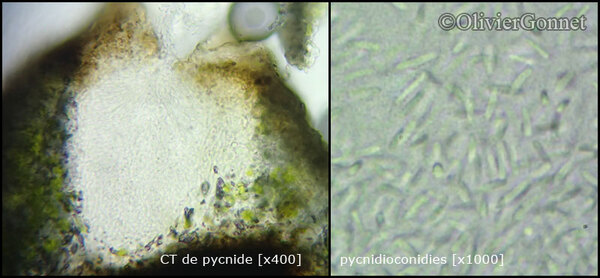
Courtesy Danièle et Olivier Gonnet - Source: hhttps://www.afl-lichenologie.fr/Photos_AFL/Photos_AFL_R/Textes_R/Rinodina_santorinensis.htm
France, 12/10/2015 - Punta di Ventilegne - Corse
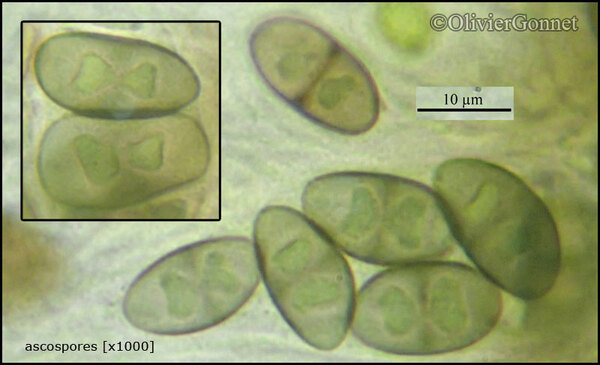
Courtesy Danièle et Olivier Gonnet - Source: hhttps://www.afl-lichenologie.fr/Photos_AFL/Photos_AFL_R/Textes_R/Rinodina_santorinensis.htm
France, 12/10/2015 - Punta di Ventilegne - Corse
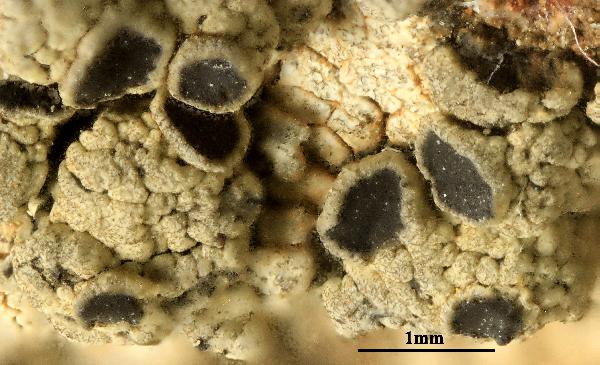

Felix Schumm - CC BY-SA 4.0
[VZR39], Italia. Pelagiae insulae: insula Linosa, in colle Nero, 100
m. Ad saxa eruptiva, supra thallum Buelliae sp. vigens. Leg. P. L.
Nimis, J. Poelt & A. Vezda, 15.4.1992. EX A. VEZDA: LICHENES RARIORES
EXSICCATI NR. 39.
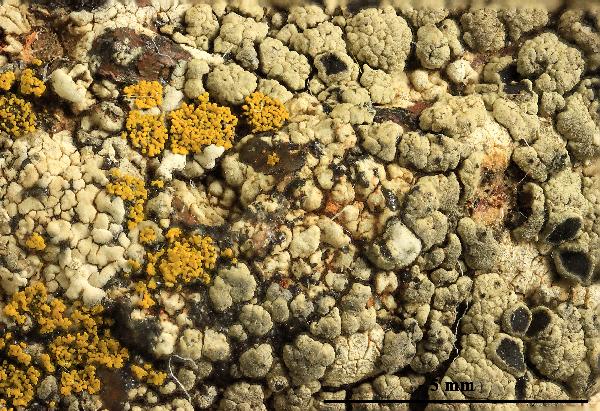

Felix Schumm - CC BY-SA 4.0
[VZR39], Italia. Pelagiae insulae: insula Linosa, in colle Nero, 100
m. Ad saxa eruptiva, supra thallum Buelliae sp. vigens. Leg. P. L.
Nimis, J. Poelt & A. Vezda, 15.4.1992. EX A. VEZDA: LICHENES RARIORES
EXSICCATI NR. 39.
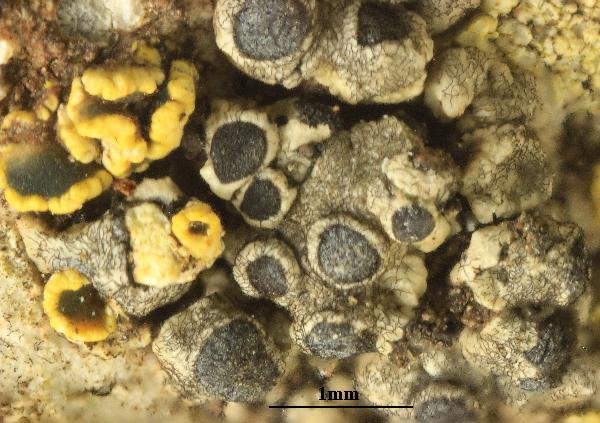

Felix Schumm - CC BY-SA 4.0
[VZR138], Insulae Canarienses, Gran Canaria. Distr. Mogán, in declivibus
orientalibus supra urbem Mogán, 500-600 m. Ad lavam, supra
thallum Caloplacae scoriophilae vel Lecanorae sulphurellae parasitans.
Leg. et det. A. Vezda. EX A. VEZDA: LICHENES RARIORES EXSICCATI
NR. 138.
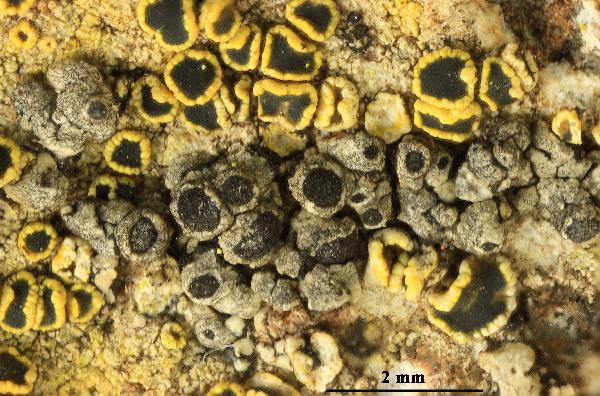

Felix Schumm - CC BY-SA 4.0
[VZR138], Insulae Canarienses, Gran Canaria. Distr. Mogán, in declivibus
orientalibus supra urbem Mogán, 500-600 m. Ad lavam, supra
thallum Caloplacae scoriophilae vel Lecanorae sulphurellae parasitans.
Leg. et det. A. Vezda. EX A. VEZDA: LICHENES RARIORES EXSICCATI
NR. 138.
Growth form: Crustose
Substrata: rocks
Photobiont: green algae other than Trentepohlia
Reproductive strategy: mainly sexual
paras crustose lichens
Taxon bound to maritime-coastal situations
Commonnes-rarity: (info)
Alpine belt: absent
Subalpine belt: absent
Oromediterranean belt: absent
Montane belt: absent
Submediterranean belt: absent
Padanian area: absent
Humid submediterranean belt: absent
Humid mediterranean belt: rather rare
Dry mediterranean belt: extremely rare

Predictive model
| Herbarium samples |


P.L. Nimis; Owner: Department of Life Sciences, University of Trieste
Herbarium: TSB (19750)
2001/11/29

Courtesy Danièle et Olivier Gonnet - Source: hhttps://www.afl-lichenologie.fr/Photos_AFL/Photos_AFL_R/Textes_R/Rinodina_santorinensis.htm
France, 12/10/2015 - Punta di Ventilegne - Corse

Courtesy Danièle et Olivier Gonnet - Source: hhttps://www.afl-lichenologie.fr/Photos_AFL/Photos_AFL_R/Textes_R/Rinodina_santorinensis.htm
France, 12/10/2015 - Punta di Ventilegne - Corse

Courtesy Danièle et Olivier Gonnet - Source: hhttps://www.afl-lichenologie.fr/Photos_AFL/Photos_AFL_R/Textes_R/Rinodina_santorinensis.htm
France, 12/10/2015 - Punta di Ventilegne - Corse

Courtesy Danièle et Olivier Gonnet - Source: hhttps://www.afl-lichenologie.fr/Photos_AFL/Photos_AFL_R/Textes_R/Rinodina_santorinensis.htm
France, 12/10/2015 - Punta di Ventilegne - Corse

Courtesy Danièle et Olivier Gonnet - Source: hhttps://www.afl-lichenologie.fr/Photos_AFL/Photos_AFL_R/Textes_R/Rinodina_santorinensis.htm
France, 12/10/2015 - Punta di Ventilegne - Corse

Courtesy Danièle et Olivier Gonnet - Source: hhttps://www.afl-lichenologie.fr/Photos_AFL/Photos_AFL_R/Textes_R/Rinodina_santorinensis.htm
France, 12/10/2015 - Punta di Ventilegne - Corse

Courtesy Danièle et Olivier Gonnet - Source: hhttps://www.afl-lichenologie.fr/Photos_AFL/Photos_AFL_R/Textes_R/Rinodina_santorinensis.htm
France, 12/10/2015 - Punta di Ventilegne - Corse


Felix Schumm - CC BY-SA 4.0
[VZR39], Italia. Pelagiae insulae: insula Linosa, in colle Nero, 100 m. Ad saxa eruptiva, supra thallum Buelliae sp. vigens. Leg. P. L. Nimis, J. Poelt & A. Vezda, 15.4.1992. EX A. VEZDA: LICHENES RARIORES EXSICCATI NR. 39.


Felix Schumm - CC BY-SA 4.0
[VZR39], Italia. Pelagiae insulae: insula Linosa, in colle Nero, 100 m. Ad saxa eruptiva, supra thallum Buelliae sp. vigens. Leg. P. L. Nimis, J. Poelt & A. Vezda, 15.4.1992. EX A. VEZDA: LICHENES RARIORES EXSICCATI NR. 39.


Felix Schumm - CC BY-SA 4.0
[VZR138], Insulae Canarienses, Gran Canaria. Distr. Mogán, in declivibus orientalibus supra urbem Mogán, 500-600 m. Ad lavam, supra thallum Caloplacae scoriophilae vel Lecanorae sulphurellae parasitans. Leg. et det. A. Vezda. EX A. VEZDA: LICHENES RARIORES EXSICCATI NR. 138.


 INDEX FUNGORUM
INDEX FUNGORUM
 GBIF
GBIF
